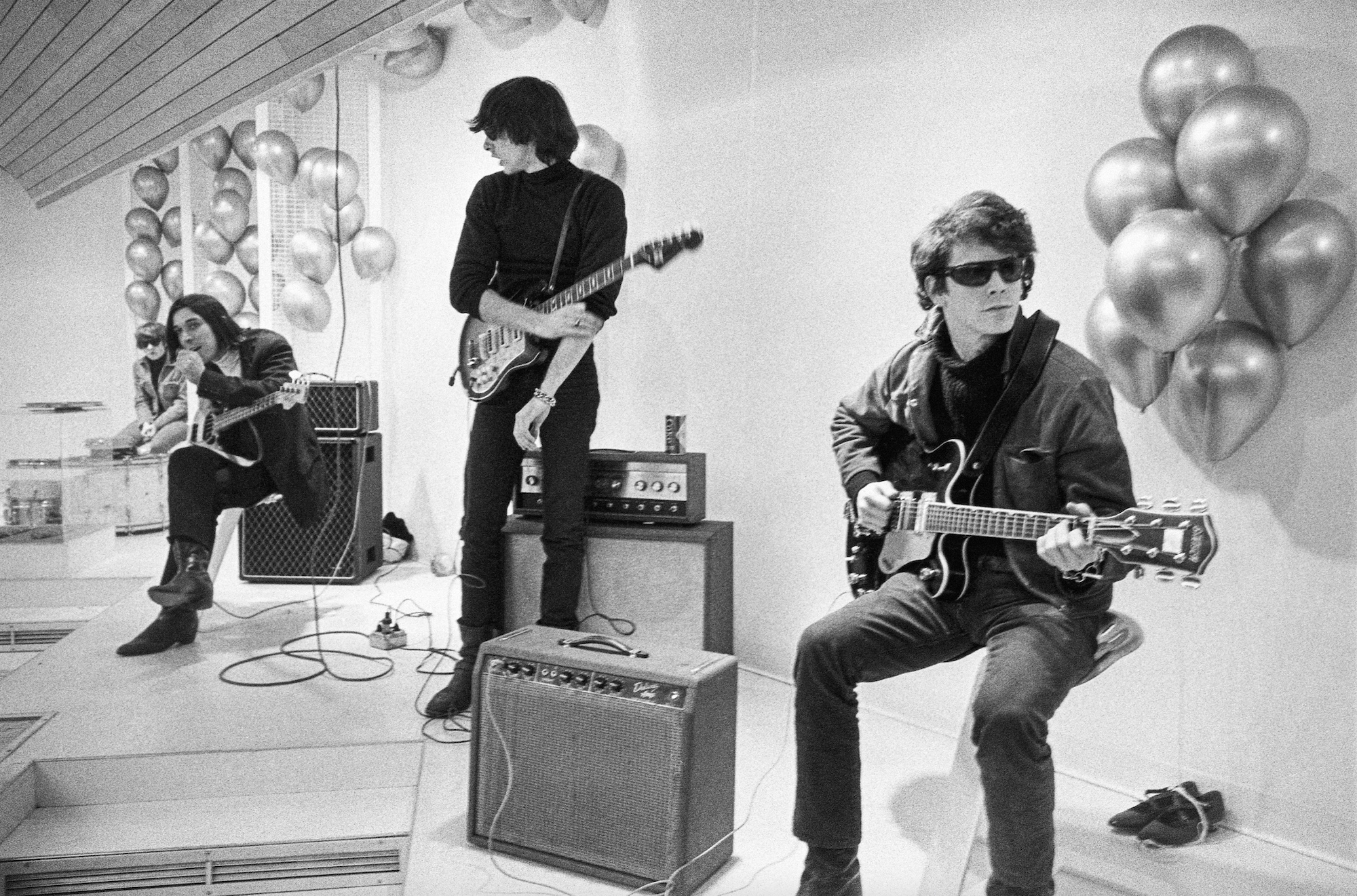Todd Haynes has been one of the best, most adventurous US directors since Superstar: The Karen Carpenter Story in 1987, with Poison, Safe, Far From Heaven and I’m Not There since (as well as the miniseries “Mildred Pierce”) all efforts for the ages—even if I’ve found some more recent features accomplished but less rewarding. It’s not a major surprise that his first full-length documentary should prove exceptional, as well as the likely-definitive work on its particular subject. The Velvet Underground is also instantly one of the great non-concert rock docs. Do you have to be a fan of the band to appreciate it? Probably not. But it will certainly help.
Probably more than any other group in the form’s history, the Velvets had a long-term impact that might’ve seemed incomprehensible during their actual lifespan, when they experienced next to no commercial success. Their off-putting image (starting with the all-black clothes), incorporation of drone/dissonance, and lyrical themes like “Heroin” were not about to find a ready audience at hippiedom’s peak. The associations with Andy Warhol and beauteous Teutonic chanteuse Nico attracted attention, but even though Lou Reed and John Cale were capable of writing pop songs (after a fashion), the effect was not inviting, the aim not accessibility. They couldn’t help it: Their default stance was confrontative. Everything that seemed wrong about them at the time felt very right once punk came along a few years later, and the V.U. catalog became practically the Magna Carta for 1980s “college rock” acts from R.E.M. to Sonic Youth.
Haynes’ two-hour movie takes 45 minutes getting to the point where all four of them (also including guitarist Sterling Morrison and drummer Maureen Tucker) met in 1965, an hour before they get to Warhol and the Factory. But their backstories are illustrated by archival materials heavy on Andy’s “Screen Tests,” as well as the general fertile early ’60s NYC milieu of gay culture, multimedia art, improvisation, and everything else the Velvets would incorporate. Their formal history encompassing four studio albums, a disastrous West Coast tour, interpersonal conflicts, beaucoup d’amphetamines, etc. seems to pass in a blink—a hypnotic blink, of course.
A sort of two-hour audiovisual collage, The Velvet Underground isn’t as depressingly negative or drug-addled as some prior chronicles of the band, if only because it focuses primarily on the music. The latterday interviewees (Tucker and Cale being the only surviving members, plus such fellow travelers as Mary Woronov, Jonathan Richman, Amy Taubin, and La Monte Young) have some colorful reminiscences, but Haynes doesn’t let the focus drift toward individual personalities too much. He’s too in love with the sum of the V.U.’s disparate, frequently clashing parts. It’s hard not to watch the film without feeling the same way.
You can have James Bond: This is the post-lockdown movie I’d be most eager to see in a theater, given the director’s exhilirating use of split-screen effects, and the still-spine-tingling sensation of hearing something like “Venus in Furs” on a really good sound system, cranked. The Velvet Underground is opening Fri/15 at area theaters including the Roxie, Balboa, Embarcadero and California (Berkeley), simultaneous with its streaming launch on Apple+.
Other new arrivals this week are also in the realm of nonfiction cinema. A very different look at the creative mindset is Witkin and Witkin, Trisha Ziff’s documentary about the identical-twin Brooklyn brothers who both became prominent visual artists. Albeit in different fields: Jerome as a figurative painter, Joel-Peter as a photographer frequently of elaborately staged, macabre tableaux. Now in their early 80s, they remain like-minded enough to have discovered they were simultaneously working on separate projects inspired by a 1939 Edward Hopper painting. Yet the two also spent a great deal of their lives incommunicado, for reasons not entirely clarified here.
Now they’re reconciled enough to share the occasional museum or gallery show, even if as Ziff interviews them separately, they remain somewhat ambivalent about one another. This straightforward chronological account of their lives offers some insight into two unique artists, though I learned that I prefer the somewhat lesser-known Jerome’s work (and personality) to Joel-Peter’s often controversial, shock-based imagery and pricklier affect. Indiepix is currently streaming Witkin and Witkin via virtual cinemas.
A long way from the rarefied concerns of art-making are the subjects of Jessica Earnshaw’s Jacinta, who are caught in spirals of addiction, incarceration, release, relapse and recidivism. At the start, 26-year-old Jacinta Hunt and her 46-year-old mother Rosemary are both serving sentences at the Maine Correctional Center. They’ve been in and out of such facilities much of their lives, Jacinta since she was 15. When she’s paroled to a sober house, things look up—her other family members are supportive, and ten-year-old daughter Caylynn is cautiously excited to have her mother back (even if she’s been almost exclusively raised by grandparents). But every prior time Jacinta has been free, she eventually began using heroin again. That history seems almost guaranteed to repeat itself.
Jacinta is somewhat grueling, because we quickly glean that probably nothing is going to break the cycle these people have fallen into—nor can you entirely blame them, as both mother and daughter experienced considerable formative trauma. (There’s good reason to think the granddaughter will fare better, as being continually disappointed by Jacinta has made her prematurely wise.) These aren’t “bad” people. Even at her self-destructive worst, the title figure is capable of putting others first, absenting herself from Caylynn’s life with the conviction “It takes a good mother to know when she can’t do what’s right.” Not entirely hopeless, but a powerfully empathetic document, Jacinta is now streaming on Hulu.
Two more new documentaries deal with different kinds of rescue operations. Steven Latham and Conrad Stanley’s The Mustangs is a lush look at a problematic population. Currently numbering around 80,000, America’s wild horses aren’t a native species—they were brought in by Spanish settlers—but are very much ingrained with our notions of the rugged West. Yet once cars displaced steeds as the principle mode of human transportation, they went from being a valued resource to a pest, viewed by ranchers as cattle’s unwanted competitors for less-than-plentiful forage. Over several decades, “big roundups” dwindled their number, the horse meat primarily used for dog food.
But around mid-century, a Reno secretary named Velma Johnson grew so appalled by these slaughters, she began a national campaign to encourage free-range horses’ survival and more humane treatment. That cause eventually caught fire, gaining support from children’s groups (such as Brownies and Scouts) as well as President Nixon, who passed a protection bill. Still, difficulties remain in stemming overpopulation, given scarcity of food and water on Federal lands where the equines roam. The film observes several programs that rehabilitate these animals for other lives, including the annual Extreme Horse Makeover (a competition for trainers) and Operation Wild Horse, an Illinois ranch whose four-legged residents themselves provide rehabilitative “healing power” for military vets with PTSD and other challenges.
Produced by several Redfords and Springsteens, The Mustangs is a deluxe nature doc, with beautiful creatures in beautiful settlings, beautifully photographed. Sometimes that eye candy feels a mite padded, as we get yet another montage of pretty pictures set to variably hokey songs by star musicians. Still, there are worse things than watching wild horses scamper in the wild, or learning new tricks in captivity. Vertical Entertainment begins releasing the feature to theaters this Fri/15.
Offering considerably less travelogue pleasantry is E. Chai Vasarhelyi and Jimmy Chin’s National Geographic production The Rescue. It chronicles events that riveted the world’s attention a little over three years ago, when monsoon flooding trapped a Thai school soccer team in a local cave they’d visited for a post-game outing. Initially feared dead, the 12 boys and their coach were found alive by divers. But the circumstances of their location in the complex, largely submerged cave made rescue daunting, almost impossible—so that the efforts dragged on for over three weeks.
It’s a rather harrowing story, with last-minute additional crises, huge risks and near-fatalities. (Two men among the various rescue bodies did die, one on-site, another from infection some time later.) Media flew in from around the world to gawk, which didn’t help. More helpfully imported were several world-class cave divers, mostly British, who dove as a hobby—yet their relevant skills far surpassed that of the Thai Navy SEAL personnel and others who were there in an official capacity. Nonetheless, the Thai government was reluctant to turn over responsibility to outsiders, even as weather conditions heightened the emergency.
The Rescue is stirring stuff (though I could have done without the closing-credits power ballad), and intriguing for its insight into the kind of personalities who might be drawn to the claustrophobic peril of cave diving as a pasttime. It opens in Bay Area theaters including the Shattuck this Fri/15.







